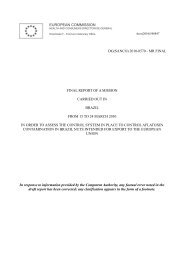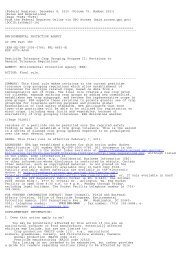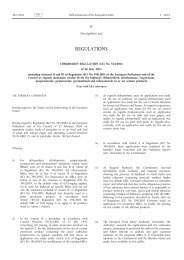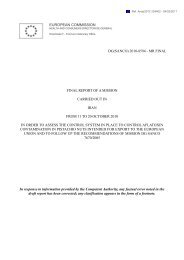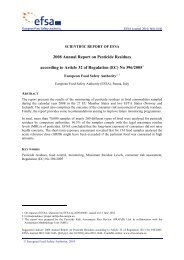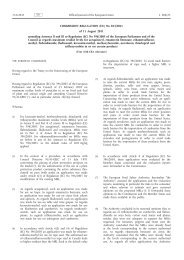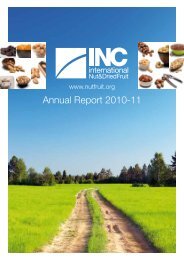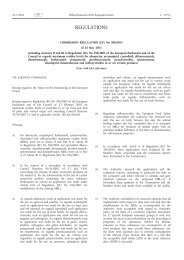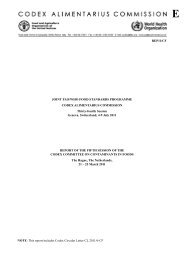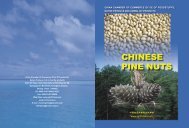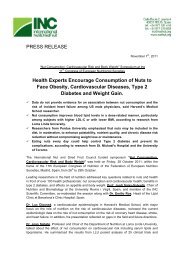REP11/PR JOINT FAO/WHO FOOD STANDARDS PROGRAMME ...
REP11/PR JOINT FAO/WHO FOOD STANDARDS PROGRAMME ...
REP11/PR JOINT FAO/WHO FOOD STANDARDS PROGRAMME ...
Create successful ePaper yourself
Turn your PDF publications into a flip-book with our unique Google optimized e-Paper software.
<strong>REP11</strong>/<strong>PR</strong> 4<br />
REPORT ON 2010 JM<strong>PR</strong> RESPONSES TO SPECIFIC CONCERNS RAISED BY CC<strong>PR</strong> (Agenda Item 4b) 5<br />
29. The Committee noted that specific concerns raised by CC<strong>PR</strong> at its last meeting will be considered when discussing the<br />
relevant chemicals under Agenda Item 5.<br />
30. The Committee expressed its appreciation to JM<strong>PR</strong> for their work and pointed out that the work of JM<strong>PR</strong> was essential and<br />
important for the CC<strong>PR</strong>.<br />
DRAFT AND <strong>PR</strong>OPOSED DRAFT MAXIMUM RESIDUE LIMITS FOR PESTICIDES IN <strong>FOOD</strong>S AND FEEDS AT STEPS 7 AND 4<br />
(Agenda Item 5) 6<br />
GENERAL<br />
31. The Delegation of the EU, supported by Norway, informed the Committee that they had concerns regarding the extrapolations<br />
used by the 2010 JM<strong>PR</strong> to propose crop group MRLs. The Delegation also informed the Committee that an updated version of its<br />
extrapolation guidance was published on the European Commission website 7 . While supporting the use of extrapolation, the EU<br />
considered that in some cases the key elements for extrapolation (existing, comparable GAP and similar residue behaviour) did not<br />
exist. In such cases the EU considered that individual commodity MRLs were preferable to setting group MRLs to avoid setting<br />
MRLs higher than necessary. The Committee agreed to consider these concerns when discussing the relevant compounds.<br />
ENDOSULFAN (32)<br />
32. The Committee decided to advance the proposed draft MRL for tea, green, black (black, fermented and dried) for adoption at<br />
Step 5/8 and to recommend subsequent revocation of the associated CXL.<br />
PARAQUAT (57)<br />
33. The Committee noted that JM<strong>PR</strong> had responded to the concern form submitted by the EU in 2010 on their acute intake<br />
concern for dried beans and potatoes, and that JM<strong>PR</strong> had confirmed that the short term dietary intake of paraquat from its uses on<br />
pulses and potato was unlikely to present a public health concern.<br />
CHLOROTHALONIL (81)<br />
34. The Committee decided to retain the CXLs for banana; cherries; common bean (pods and/or immature seeds); cranberry;<br />
onion, bulb; peach; peppers, chilli, dried; peppers, sweet (including pimento or pimiento) and tomato for four years under the periodic<br />
review, noting the manufacturers would submit supporting data for these commodities.<br />
35. The Committee noted the reservations of the Delegations of the EU and Norway on the proposed draft MRLs for brussels<br />
sprouts due to a lower MRL of 5 mg/kg derived from use of the OECD calculator, for cucumber due to an insufficient data set, for<br />
gherkin; summer squash and root and tuber vegetables due to the extrapolation used by JM<strong>PR</strong>.<br />
36. The Committee also noted the request from the EU for JM<strong>PR</strong> to conduct a short term dietary intake risk assessment for<br />
chlorothalonil in leeks.<br />
37. The Committee agreed to advance all the proposed draft MRLs to Step 5/8 and to recommend revocation of the CXLs for<br />
barley; barley straw and fodder, dry; beans (dry); broccoli; brussels sprouts; cabbages head; carrot; cauliflower; celery; celery<br />
leaves; cucumber; currants, black, red, white; grapes; melon, except watermelon; parsley; peanut; potato; squash, summer; sugar<br />
beet; sweet corn (corn on the cob); wheat; wheat straw and fodder, dry and winter squash as recommended by 2010 JM<strong>PR</strong>, noting<br />
that the manufacturer will submit new data for carrots.<br />
DINOCAP (87)<br />
38. The Delegation of Australia informed the Committee that dinocap and meptyldinocap were closely related compounds and<br />
that the CXL for dinocap needed to be revised to accommodate residues from the use of meptyldinocap, as recommended by the<br />
2010 JM<strong>PR</strong>.<br />
5 Section 3 of the 2010 JM<strong>PR</strong> Report.<br />
6 CX/<strong>PR</strong> 11/43/3; CX/<strong>PR</strong> 11/43/3-Corrigendum; CX/<strong>PR</strong> 11/43/3-Add.1 (comments from Australia, Brazil, Canada, Iran and Thailand). Additional comments from<br />
Kenya (CRD 5); EU (CRDs 14, 16, and 17); and China (CRD 19).<br />
7 http://ec.europa.eu/food/plant/protection/resources/publications_en.htm



